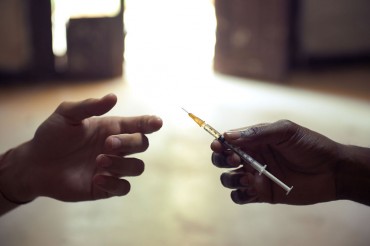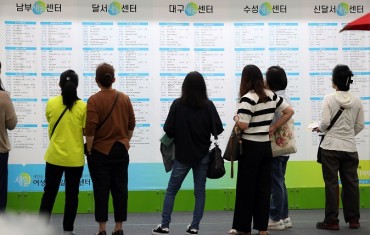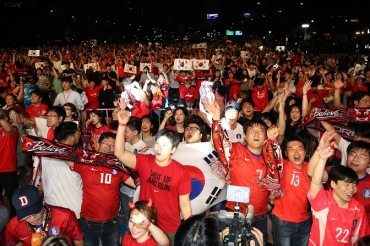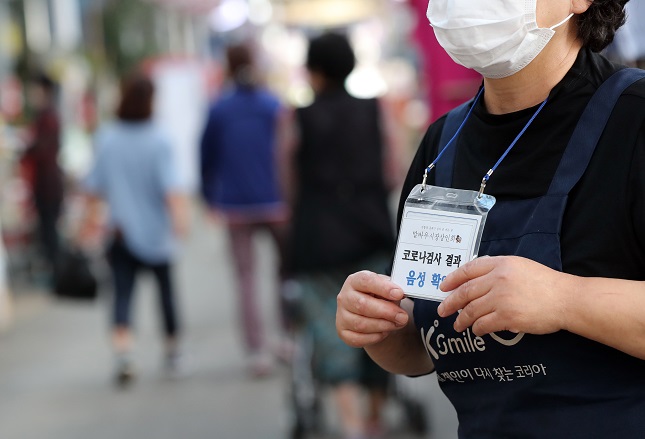
A shopkeeper in a traditional bazaar in the southern city of Gwangju on Sept. 12, 2020, wears a sign informing customers that she has tested negative for the new coronavirus after the market was closed for two days due to COVID-19 cases reported nearby. (Yonhap)
SEOUL, Sept. 12 (Korea Bizwire) — South Korea’s new virus cases stayed below 200 for the 10th day in a row Saturday, but health authorities remain anxious about no letup in sporadic cluster infections and untraceable cases across the country.
Over the weekend, health authorities plan to determine whether to further extend stricter social distancing measures in the greater Seoul area by another week.
The country added 136 more COVID-19 cases, including 118 local infections, bringing the total caseload up to 22,055, according to the Korea Disease Control and Prevention Agency (KDCA).
The agency, an upgraded successor of the Korea Centers for Disease Control and Prevention (KCDC), officially set sail Saturday in a bid to elevate the country’s capacity to contain infectious diseases, such as COVID-19.
The Saturday tally marked a solid drop from the 176 and 155 cases reported Friday and Thursday, respectively.
The country’s new virus cases have been in the triple digits since Aug. 14, due mainly to cases tied to a conservative church in northern Seoul and an anti-government rally in mid-August. Daily infections soared to 441 on Aug. 27.
The number of additional virus cases has recently slowed to the 100 range on the back of stricter antivirus curbs, but it has not been on a markedly downward trend.
“New daily infections have stubbornly stayed over 100, and cluster infections of more or less than 20 cases have continued to show up outside of the capital area,” Health Minister Park Neunghoo said in a government COVID-19 response meeting earlier in the day.
“The situation is in a very worrisome state.”
The minister said about 20 percent of recent daily new infections have stemmed from untraceable transmission sources, resulting in the virus “quietly spreading among local communities.”
Park said that the country needs “more stringent and thorough (virus) management” now than during its first wave of transmissions centered around the southern city of Daegu and North Gyeongsang Province in late February.
“Currently, the virus transmissions are sporadically continuing across the country … with 35 percent of (new) infection cases reported among people aged 60 or older,” he said.
Kwon Jun-wook, a high-ranking health official, said later that ahead of the coming winter season, the country must avert a double epidemic of COVID-19 and influenza.
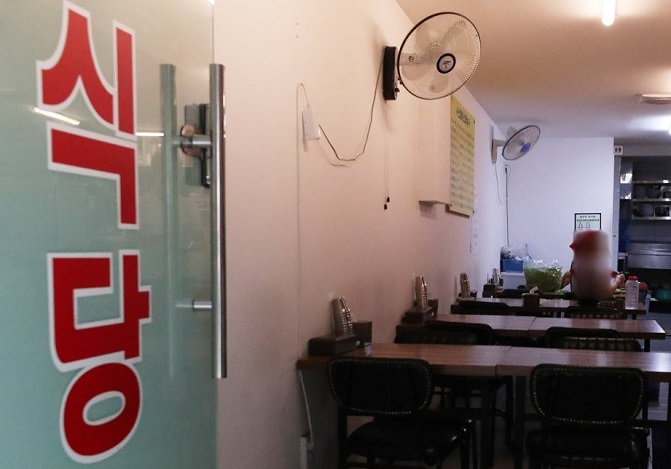
A restaurant in the famous Myeongdong shopping district in central Seoul is empty during lunch hours on Sept. 11, 2020, amid Level 2.5 social distancing rules in place. (Yonhap)
On Aug. 30, the country imposed Level 2.5 social distancing measures for eight days in the wider capital region, home to half of the country’s 51.6 million population, and extended it by a week until Sunday.
Under the scheme, restaurants can operate only from 5 a.m. to 9 p.m. and only takeaway or delivery is permitted outside of the permitted hours.
Franchise coffee houses, bakeries and ice cream shops are allowed to only offer takeaway or delivery at all times.
This weekend, health authorities will decide whether to extend the tougher curbs again.
Health authorities had initially set the goal of pushing daily cases below the 100 threshold before lifting the tougher distancing requirements.
But the prolonged business restrictions have been devastating to smaller business owners and the broader economy.
Government sources said the decision is likely to be announced Sunday.
Health authorities are warming to the option of retaining the present Level 2.5 social distancing while partly lifting the business restrictions imposed on restaurants and coffee shops, according to the sources.
Of the new locally transmitted cases, 50 cases were from Seoul and 28 from Gyeonggi Province that surrounds the capital. Incheon, west of Seoul, added eight cases.
Other municipalities reported new infections, with the central city of Daejeon adding seven cases and South Chungcheong Province reporting six cases.
Cases traced to the protest rally in central Seoul on Aug. 15 added one more to a total of 565 cases as of noon on Saturday, according to health authorities.
Severance Hospital, one of the major general hospitals in Seoul, reported four more cases to a total of 23.
A Buddhist propagation facility in western Seoul added one more COVID-19 case, bringing the number of cluster infections there up to 23 cases.
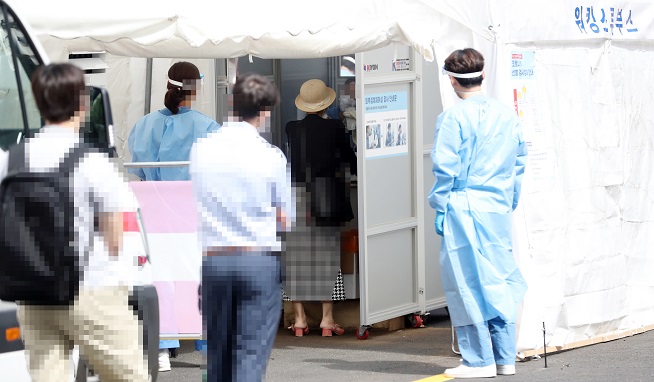
Citizens wait in line to be tested for COVID-19 at a makeshift clinic in central Seoul on Sept. 11, 2020. (Yonhap)
Other cluster infections continued to pop up across the nation, including four more COVID-19 patients reported in a day care center for elderly people in Icheon, Gyeonggi Province. The cumulative number of infections there stood at 18.
Three more COVID-19 cases were traced to a health care product business forum in the central city of Daejeon to a total of 54 cases.
The country, meanwhile, reported 18 imported cases, including four from Australia and three from the United States.
South Korea reported five more deaths, raising the death toll to 355. The fatality rate came to 1.61 percent. Two more deaths were additionally reported as of noon on Saturday, which will be counted toward the daily tally for Sunday.
The number of patients in serious or critical condition came to 164, down 11 from the previous day. Slightly more than 23 percent of them were people in their 80s or older, while another 40 percent were patients in their 70s.
Of all the new cases confirmed during the past two weeks, 23.4 percent were classified as having been infected through untraceable sources, according to officials.
The total number of COVID-19 patients released from state-designated quarantine after making full recoveries stood at 18,029, up 413 from the previous day. So far, 81.75 percent of the patients reported here have been cured.
South Korea has carried out 2,135,457 COVID-19 tests since Jan. 3. The country reported its first case on Jan. 20.
(Yonhap)



